Lesson
2
South Dakota Becomes a State
|
|
|
|
Timeline |
|
|
1788 |
|
United States Constitution ratified |
|
1861 |
|
Dakota Territory created |
|
1883 |
|
Capital moved to Bismarck |
|
1889 |
|
South Dakota becomes a state |
|
1904 |
|
Pierre wins permanent state capital |
|
1910 |
|
State capitol finished |
|
1934 |
|
Tribal governments set up |
|
1978 |
|
Intertribal court of appeals started |
|
At first, there were only thirteen
states. A new part of the country was called a territory. When
enough people lived there, they could ask Congress to make it a
state. There were good reasons for wanting statehood. People who
lived in territories could not vote for their leaders. Their
governors were not elected. They were appointed, or put in power, by the president
of the United States. The people could not check the power of a
governor by voting. Also, they could not elect members of Congress
to vote for laws in Washington, D. C.
This was a problem in Dakota
Territory when Nehemiah Ordway was governor. Ordway and his
political
friends moved the capital out of Yankton. The year was 1883.
Yankton was in the southern half of the territory. Most of the
people lived in this area. Bismarck became the new capital. It was
in the north and central part of the territory. The people could not
vote the governor out of office to show that they were not happy.
Leaders in the south thought it was time for a change. They asked
Congress to make southern Dakota a state all by itself.
|
|
People had talked about splitting up the
territory for a long time. One plan called for a split down the
middle. This would make the states of Eastern Dakota and Western
Dakota. Another plan made the southern half into a state named
Dakota. The northern half would become Pembina Territory. Yet
another plan carved out three states. They were North Dakota, South
Dakota, and the Black Hills. All of these plans failed.
|
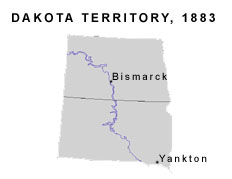
|
|
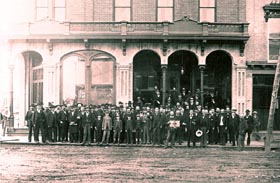
Photo courtesy of South Dakota State
Historical Society
|
Now leaders in the southern half of
Dakota Territory got down to work.
Delegates from around the area met in
Sioux Falls. They worked on a plan for one state called South
Dakota. The men wrote a state constitution. They asked Senator Benjamin
Harrison from Indiana to put a bill into the United States
Congress. The bill asked that South Dakota be made a state. The bill
did not pass. The same thing happened two years later. The reason
was simple. Most people in Congress were Democrats. They knew that
most people in Dakota were Republicans. They did not want more
Republicans in Congress.
|
|
|
|
|
Things changed when Benjamin Harrison
became president. He was a Republican and a friend of Dakota. Soon
the bill for statehood passed in Congress. It was called the Omnibus
Statehood Bill. It said that the states of North Dakota and South
Dakota could be created. The year was 1889.
Once again, delegates met in Sioux
Falls. They wrote a final state constitution. Voters in southern
Dakota gave it their okay that fall. They chose Pierre as the state
capital. They elected Arthur Mellette as governor. He was the
last territorial governor, and he was a good one. The people wanted
him to stay.
|
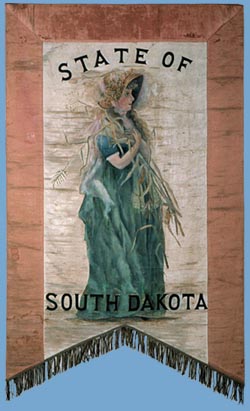
Photo courtesy of South Dakota State
Historical Society
|
|
|
|
|
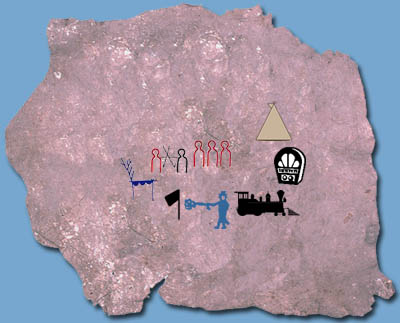
Winter Count
|
In November 1889, President Harrison
signed the law that made both North and South Dakota into states.
Before he did so, he shuffled the papers on his desk. He covered up
the names on the papers. No one knows which state he signed into law
first. The Dakotas are twinsóborn at the same time. They are
listed in alphabetical order, though. North Dakota comes first. It is said to
be the thirty-ninth state. South Dakota is said to be the fortieth,
but nobody knows for sure. They are equals.
|
|
|
|
|
Pierre was to be
the capital for just one
year. During that time, voters could think about it. Where did they
want to put the
permanent seat of government? Some people
thought Pierre was the perfect spot. It was in almost the exact
center of the state. Other people pointed out that Pierre might be
in the center of the state but it was not in the center of
population. Most people lived in the eastern one-third of South
Dakota.
|
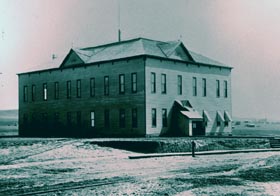
Photo courtesy of South Dakota State
Historical Society
|
|
|
|
|
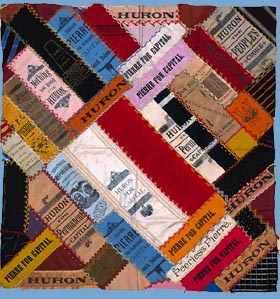
Photo courtesy of South Dakota State
Historical Society
|
It would take two more elections to
decide what town would be the permanent capital. Many towns wanted to be
the capital. Government brought jobs to town. It gave a place
prestige.
The first election was held in 1890. Huron challenged Pierre for the
honor. Pierre won again. In 1904, Mitchell tried to win the capital.
Again, Pierre won.
|
|
|
|
|
People were getting tired of these
challenges. They cost a great deal of money. They kept people on edge. The
state legislature put a stop to them. It voted to build a permanent
capitol. Up until this time, the state capitol had been a wooden
building. Now it would be a stone building worthy of the seat of
government. Today the South Dakota capitol is a treasure that all
citizens can visit.
|
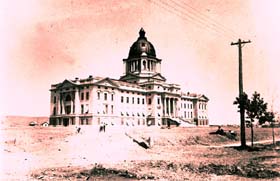
Photo courtesy of South Dakota State
Historical Society
|
|
|
|
| Vocabulary |
|
| delegates (n.),
representatives; people who speak for the people who elected
them
permanent (adj.), long-lasting or constant
|
political (adj.), having to do with government work
prestige (n.), honor or esteem
|
|
|